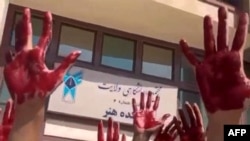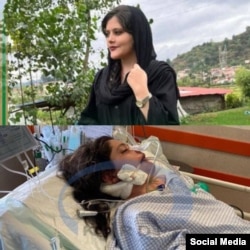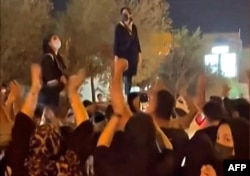Iran's clerical rulers have faced the biggest protests in years since Mahsa Amini died last month in the custody of the morality police who enforce the Islamic Republic's strict dress code.
Following is a timeline of events since her arrest:
Sept. 13 - Mahsa Amini, from Iran's Kurdistan region, is detained by morality police in Tehran, the Iranian capital, because of her "inappropriate attire."
Sept. 16 - Amini dies after falling into a coma. Police say she suffered a heart attack after being taken to a station to be "educated." Her family denies she had any heart problems. Her father later says she had bruises on her legs, and he holds police responsible for her death. President Ebrahim Raisi demands an investigation. Protests begin on social media and in the street.
Sept. 17 - Protests erupt during Amini's funeral in Saqez, her hometown in Kurdistan. Security forces fired tear gas. Protests spread to the provincial capital. Chants of "death to the dictator" are heard, with some women removing headscarves.
Sept. 18 - Demonstrations spread. Hundreds gather around the University of Tehran, shouting "Woman, Life, Freedom."
Sept. 19 - Protests intensify, taking place in Rasht, Mashhad, Isfahan and Tehran, where security forces and demonstrators clash.
Sept. 20 - An aide to Supreme Leader Ayatollah Ali Khamenei says he visited Amini's family to pay condolences and that Khamenei was pained by her death. An official blames terrorist groups for deaths in Kurdistan.
Sept. 21 - Authorities curb access to Instagram and WhatsApp. Official sources confirm eight deaths in the unrest, including a member of the police and a member of the Basij militia.
Sept. 22 - Protesters in Tehran and several other cities torch police stations and vehicles. Raisi says "acts of chaos" are unacceptable. The United States imposes sanctions on Tehran's morality police.
Sept. 23 - The state organizes rallies in several cities with marchers calling for protesters to be executed. The army vows to "confront the enemies' various plots." State TV says the death toll is 35.
Sept. 24 - After accusing armed Iranian dissidents of involvement in the unrest, the Revolutionary Guards carry out the first of several attacks on Iranian militant opposition bases in the Kurdish region of northern Iraq.
Raisi says Iran must deal decisively with protests. State TV says the death toll is 41.
Sept. 27 - Security forces clash with demonstrators in dozens of cities. Despite the crackdown, social media from inside Iran continue to show protesters chanting, "Woman, Life, Liberty," while women wave and burn veils.
Sept. 30 - State TV says militants fire on a police station in the southeastern city of Zahedan, prompting a shootout. State TV says 19 people are killed. The Guards say four of its forces and the Basij are killed. Amnesty International later says security forces killed 66 people, including children, in the deadliest day since protests started.
Oct. 3 - In his first comments on the unrest Khamenei backs the security forces. He says Amini's death "deeply broke my heart" and calls it a "bitter incident" provoked by Iran's enemies. Defying his warning, Iranians in several cities chant "We want regime change" and "death to Khamenei."
Oct. 7 - Authorities deny reports security forces killed a 16-year-old girl, saying she committed suicide. It is the second time in a week they said a teenage girl died falling from a roof. A coroner's report denies Amini died from blows to the head and limbs while in custody, linking her death to pre-existing conditions.
Oct. 8 - Female students chant "get lost" as Raisi visits their university campus in Tehran.
Oct. 10 - Protests spread to Iran's energy sector, according to reports on social media showing workers at Abadan and Kangan oil refineries and Bushehr Petrochemical Project demonstrating.
Oct. 13 - Members of the Basij militia, troops which have been at the forefront of repressing popular unrest for decades, deploy in Kurdish areas where seven people are killed in protests.








